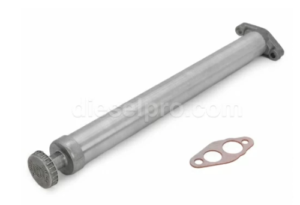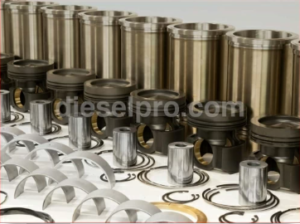The Caterpillar 3512 marine engine is one of the most durable and reliable diesel engines in the marine industry. Used in tugboats, offshore supply vessels, cargo ships, and fishing boats, it is built to withstand continuous-duty operation under demanding conditions.
However, even the toughest engines require regular maintenance to operate efficiently and avoid costly breakdowns. A well-maintained 3512 engine can run for tens of thousands of hours, while neglecting key maintenance tasks can lead to overheating, loss of power, and premature failure.
This guide outlines essential maintenance practices to keep your Caterpillar 3512 running strong, ensuring maximum performance, fuel efficiency, and engine longevity.
1. Perform Regular Oil Changes
Why It’s Important:
Oil is the lifeblood of the engine, providing lubrication, cooling, and contaminant removal. Over time, oil breaks down and loses its ability to protect internal components, leading to increased friction, overheating, and premature wear.
Oil Change Best Practices:
✔ Change oil every 250–500 hours of operation, depending on workload and operating conditions.
✔ Use high-quality diesel engine oil that meets Caterpillar’s specifications.
✔ Replace oil filters during every oil change to prevent contaminants from circulating.
✔ Check for metal particles or sludge in used oil—this could indicate internal engine wear.
Skipping oil changes can lead to catastrophic engine failure, making this one of the most critical maintenance tasksfor your 3512 engine.
2. Inspect and Maintain the Cooling System
Why It’s Important:
The Caterpillar 3512 operates under high-load conditions, generating a significant amount of heat. The cooling systemensures that engine temperatures remain within safe operating limits.
Marine Raw water Pump for Caterpillar 3512 Marine Engine
Cooling System Maintenance Checklist:
Inspect the raw water pump & impeller – Replace worn or damaged impellers to ensure proper water circulation.
Check coolant levels & condition – Low coolant can lead to overheating and cylinder head warping.
Flush the cooling system regularly – Remove scale buildup, rust, and debris that can block coolant flow.
Inspect hoses & connections for leaks – A small coolant leak can quickly escalate into an engine overheating issue.
Monitor heat exchanger performance – Ensure the heat exchanger is clean and free of blockages.
Regular cooling system maintenance prevents overheating, cracked cylinder heads, and blown head gaskets, keeping your 3512 engine operating at peak efficiency.
3. Keep the Fuel System Clean

Why It’s Important:
A dirty fuel system can lead to clogged injectors, poor combustion, reduced power output, and excessive fuel consumption. Keeping the fuel system clean and properly maintained is crucial for maximizing engine efficiency and reliability.
Fuel System Maintenance Steps:
✔ Replace fuel filters at recommended intervals – Dirty filters restrict fuel flow, reducing performance.
✔ Use high-quality diesel fuel – Low-quality or contaminated fuel can damage injectors and cause carbon buildup.
✔ Drain water from the fuel separator – Water in fuel leads to injector damage and poor combustion.
✔ Inspect fuel injectors – Worn injectors can cause misfires, excessive smoke, and loss of power.
By keeping the fuel system clean, you ensure that your Caterpillar 3512 operates efficiently while reducing costly repairs.
4. Inspect & Maintain the Turbocharger
Why It’s Important:
The turbocharger plays a vital role in the 3512’s performance, increasing air intake efficiency and combustion. A damaged or clogged turbocharger leads to reduced power, increased fuel consumption, and black smoke from the exhaust.
Turbocharger Maintenance Tips:
Check for excessive oil consumption – Oil leaks in the turbocharger can cause burnt oil smoke.
Inspect for carbon buildup – A dirty turbo reduces airflow, leading to poor performance.
Ensure proper lubrication – Low oil pressure can damage turbo bearings.
Monitor boost pressure – A drop in boost could indicate leaks or worn components.
Routine turbo maintenance ensures maximum engine efficiency, fuel savings, and extended service life.
5. Monitor the Cylinder Head & Valve System
Why It’s Important:
The cylinder head and valve train ensure proper compression, combustion, and exhaust flow. A faulty cylinder headcan cause compression loss, overheating, and major engine damage.
Cylinder Head & Valve Maintenance Steps:
✔ Inspect for cracks or leaks – A cracked cylinder head can lead to coolant loss and overheating.
✔ Check valve lash clearance – Improper valve adjustment can reduce power and increase wear.
✔ Replace worn valve seals – This prevents oil from leaking into the combustion chamber.
✔ Look for excessive carbon buildup – Carbon buildup on valves affects airflow and combustion.
Addressing cylinder head and valve issues early prevents expensive repairs and keeps your 3512 running smoothly.
6. Maintain the Aftercooler System
Why It’s Important:
The aftercooler cools compressed air from the turbo before it enters the combustion chamber, improving power and efficiency. If it becomes clogged or damaged, air intake temperature increases, leading to reduced power and higher fuel consumption.
Aftercooler Maintenance Tips:
Inspect for corrosion or leaks – Saltwater exposure can damage aftercoolers over time.
Clean the aftercooler core – Removes debris, oil residue, and soot buildup.
Ensure proper airflow – Blocked aftercoolers reduce engine efficiency.
Keeping the aftercooler clean and functional ensures optimal engine performance and fuel efficiency.
7. Check and Replace Worn Belts & Hoses

Why It’s Important:
Belts and hoses play a crucial role in driving engine accessories and circulating coolant. A worn belt or leaking hosecan result in cooling system failure or accessory damage.
Preventive Maintenance for Belts & Hoses:
✔ Inspect belts for cracks, fraying, or looseness – Replace worn belts before they fail.
✔ Check hoses for soft spots, bulges, or leaks – Swollen hoses indicate internal damage.
✔ Ensure proper tension – Loose belts cause slipping and reduced efficiency.
Replacing belts and hoses before failure prevents unexpected downtime and costly repairs.
8. Keep Exhaust & Emissions System Clean
Why It’s Important:
A clogged or failing exhaust system reduces engine efficiency, increases fuel consumption, and causes excessive smoke production.
Exhaust System Maintenance Checklist:
Inspect for exhaust leaks – Leaks can cause loss of engine power.
Check for excessive smoke – Black smoke may indicate fuel issues, while white smoke suggests coolant leaks.
Ensure proper ventilation – Restricted airflow leads to higher emissions and overheating.
A healthy exhaust system ensures optimal performance and compliance with emissions regulations.
Final Thoughts: Keep Your Caterpillar 3512 Running Strong
The Caterpillar 3512 is a high-performance marine engine, but it requires regular maintenance to ensure maximum efficiency, longevity, and reliability.
Key Takeaways:
✅ Change oil and filters regularly to prevent internal wear.
✅ Inspect and maintain the cooling system to avoid overheating.
✅ Keep the fuel system clean for optimal combustion.
✅ Monitor the turbocharger and aftercooler for maximum efficiency.
✅ Perform cylinder head and valve inspections to prevent power loss.
✅ Replace worn belts, hoses, and exhaust components before failure.
By following these simple maintenance steps, you can ensure your Caterpillar 3512 runs at peak performance for years to come.
Need Aftermarket Parts for Your 3512?
Diesel Pro Power offers high-quality aftermarket parts to keep your Caterpillar 3512 in top condition.
Would you like recommendations on oil filters, cylinder heads, or rebuild kits? Let us know—we’re here to help!
Parts Catalog for CAT 3512
- Overhaul Kits for Caterpillar 3512: Complete kits to refresh your engine, restoring power and efficiency and extending its lifespan.
- Fresh Water Pumps for Caterpillar 3512: These pumps keep your engine cool by circulating fresh water through the cooling system, crucial for long hours of operation.
- Raw Water Pumps for Caterpillar 3512: Essential for marine applications, these pumps draw seawater into the system to regulate engine temperature, preventing thermal damage.
- Cylinder Heads for Caterpillar 3512: Engineered to handle high pressures, these cylinder heads support efficient combustion and reliable power output.
- Fuel Pumps for Caterpillar 3512: Fuel pumps ensure optimal combustion by delivering fuel at the correct pressure, enhancing engine smoothness and fuel economy.
- Aftercooler For Caterpillar 3512: Aftercooler is used to cool the compressed air before it enters the engine’s combustion chamber, enhancing combustion efficiency and improving overall engine performance by reducing the temperature of the air intake.
- Injectors for Caterpillar 3512: Precision-engineered injectors ensure fuel is delivered correctly to maximize power, efficiency, and reduce emissions.
- Oil Coolers & Oil Lubricating Pump for Caterpillar 3512: These components help maintain oil viscosity by cooling the oil and pumping it through the engine for lubrication.
- Turbos for Caterpillar 3512: Designed to boost airflow into the combustion chamber, turbos enhance power and efficiency, ideal for heavy-duty applications.
- Crankshafts for Caterpillar 3512: Our crankshafts convert engine power into rotational motion, ensuring reliable performance under demanding conditions.
- Camshafts for Caterpillar 3512: These control the engine’s valve timing, crucial for efficient combustion and maintaining optimal performance.
- Gaskets for Caterpillar 3512: High-quality gaskets prevent leaks, maintain compression, and ensure overall engine efficiency and durability.



 Free US Calls: 1-888-433-4735
Free US Calls: 1-888-433-4735 International: 305-545-5588
International: 305-545-5588


